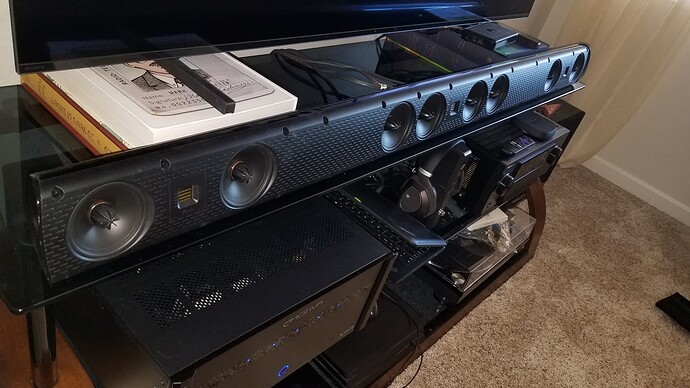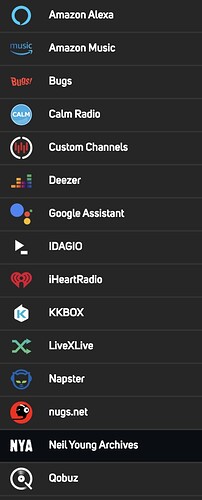Even if gear does, will audiophiles?
Yes, @Danny, I used to believe and promote that mindset.
But the Meridians made me dislike lock-in: if one part of the integrated system doesn’t keep up with modern technology, you have to replace the whole thing.
In my case, electronics doesn’t make me freak out, but speakers do. Wilsons shook me.
So the next time I won’t face lock-in.
If there is a next time — man you’re insane!
Have you checked out Dante? Is that what you mean? What is Dante? | Audinate | Dante Pro AV Networking
What audio devices support Dante?
If it is difficult to get audio devices to support network (IP), it will likely to get them to support a proprietary and apparently professional-grade protocol over IP, don’t you think?
This is a problem with all the IP audio protocols – they’re all proprietary. There’s nothing comparable to USB Audio class 2 for IP. In fact, all the widely implemented audio protocols are defined over serial connections with limited latency: AES, S/PDIF, USB Audio.
EDIT: There is a dog’s breakfast of RTP, RTSP, and RTCP, but they are usually intermixed with various proprietary components as well. And DLNA broke up in 2017.
It strikes me that the views discussed in this forum are interesting.
Some people complain about the cost of Roon, at $700, and debate the option of monthly rental (or leasing).
Some people complain about the cost of a Nucleus, at $1459, and debate the option of installing ROCK on a NUC.
And yet, here people worry about the cost of implementing a network port in a device, and instead recommend an external streamer: at the Roon store Sonore is listed at $2100 - $4850, Silent Angel at $1100, Primare at $750 or iFi at $400. Allo is $400. Plus cables.
And the Raspberry Pi at about $100, or the Google CCA at $35.
Maybe the real worry is that the folks doing audio often seem to get “implementing a network port” wrong.
This is always a hobby where people will strive to put together the best of the best to achieve a unique and custom experience. The cycle of this hobby really has not changed. You get the best you can within a budget. You upgrade a piece or two over time. You realize you have 5 figures (or more) in cables. Over time our dream crashes and the chase isn’t the same. You get envious of how clean the neighbor’s system is because they use a soundbar, yes a SOUNDBAR, as their hifi with 1 HDMI cable and 1 power cable (which both were included in the box with the soundbar).
This is the point where we go from “separates 4 ever!!” evangelism to “single box rules!” evangelism.
Both are right. Both have their place. Get the best your budget allows and you can live with looking at for years and stay away from the snake-oil. I, personally, want as many silly boxes as I can possibly cram into my system because it gives me more to research and tweak and brag about. In fact, I was just looking at a 4 chassis pre-amp. Yes, four boxes as they put the L channel and R channel in separate chassis, controller, and PSU. Gorgeous and way outside my budget ![]() When I sell my house and downsize I’ll probably end-up with something like a Naim Mu-so as the entirety of my hifi. At least it’s a significant step-up from a soundbar. Happy listening.
When I sell my house and downsize I’ll probably end-up with something like a Naim Mu-so as the entirety of my hifi. At least it’s a significant step-up from a soundbar. Happy listening.
A bit off topic, but the demise of the CCA frustrates me…
not really anymore… and my last one just died ![]()
The RPi + HAT is best cheap solution, but it’s not easy to get an RPi4 right now, and not cheap like the Chromecast Audio. Sucks.
Ha — I got a CCA a while back, and then paid a lot more than $35 for an “audiophile” Toslink cable.
There are a ton on the Pro Audio side (including nice in-ceiling PoE speakers). Dante is licensed though and you probably won’t get a “Hifi” manufacturer to license it. AVB (IEEE 802.1) would be the preferred if you didn’t want to license anything but fewer manufacturers support it (and it requires the entire network understand the protocol, including switches, so becomes more complicated to implement). But, really, both of these things are trying to solve for an issue hifi doesn’t have. That is a bunch of analog interfaces that used to need all their own runs into a board. What these systems solve is the ability to run all these sources into the same “network” and then break-out the individual sources in software. For example, Dante supports up to 512 inputs and 512 outputs, all software configurable, across the same network. Fun stuff… I just picked up a Dante controller to play with. Need to find the time to play though.
What is a “Hifi“ manufacturer? JBL supports Dante in all their Synthesis products, which is their top AVR line. Trinnov has audio over IP integrated in their Pro series and plans to integrate it in their Altitude series because of the rising demand.
Yes, it’s a shame. I bought a stockpile when they were selling for $25.
But you can still get cheap Chromecasts with HDMI outputs. And the mass-market has moved from stereo FM receivers to AVRs.
Really, it’s the audiophiles who refuse to adapt to the changing world, the world that’s embracing HDMI as the digital A/V connection (note the “A” in A/V), that’s embracing music via Echos and Apple HomePods and soundbars. This obsession with stereo component systems is some kind of nostalgic hysteric memory of 1970’s Playboy ads.
You and me both…I used to promote that wonderful little puck anywhere and everywhere when you could pick them up all day long at $50 or less on eBay.
Still use three myself as also an excellent cheap way to get Roon into gear never designed for the modern age.
I use the 3.5mm out to twin RCA to feed old 70’s receivers…
Ok, enough off topic, apologies ![]()
Although pretty sure I read a rumor somewhere of late they were considering bringing them back?
I think the main driver for network support in the consumer space will be streaming, like Spotify and Apple. Nobody spins disks anymore, Roon is a small market. The world streams.
Examples:
Linn lists TIDAL, Qobuz, Spotify Connect, Airplay, Roon, TuneIn, Calm Radio.
dCS lists Spotify, TIDAL, Qobuz, Deezer, internet radio, Roon Ready, AirPlay and UPnP.
Bluesound lists Amazon Music, Bugs, Calm Radio, Custom Channels, Deezer, Idagio, iHeartRadio, KKBox, LiveXLive, Napster, nugs.net, Neil Young Archives, Qobuz, Qsic, Radio Paradise, SiriusXM, Spotify, SoundMachine, Tidal, TuneIn, Tunify, Roon. EDITED per BCBC
Sonos lists Airplay, Amazon Music, Pandora, Spotify, TIDAL, and Roon.
That’s a wide price range.
Where the world is going.
Both of these are examples of things that can go both ways and that’s excellent. I expect to see more of this as time moves on. However. I’d still consider both of these lines “Pro” as sourcing this gear and installing it is almost always through a custom installer. Although plenty on this forum would be perfectly fine getting through the set-up themselves this custom install process is very very different then, say, a Marantz AVR that I can source from anywhere and run the calibration myself hooked up to darn near any set of speakers.
I see that now. Yes, IC DACs are absolutely fine. I have a few, but I still enjoy a discrete lemon. ![]()
My current preference is separate Hi-Fi components, as I don’t have all my eggs in one basket. I can live with the few additional cables tucked away behind my main setup.
Bluesound supported services as of today:
Amazon Alexa, Amazon Music, Bugs, Calm Radio, Custom Channels, Deezer, Idagio, iHeartRadio, KKBox, LiveXLive, Napster, nugs.net, Neil Young Archives, Qobuz, Qsic, Radio Paradise, SiriusXM, Spotify, SoundMachine, Tidal, TuneIn, Tunify
Wow.
Well, I rest my case.


